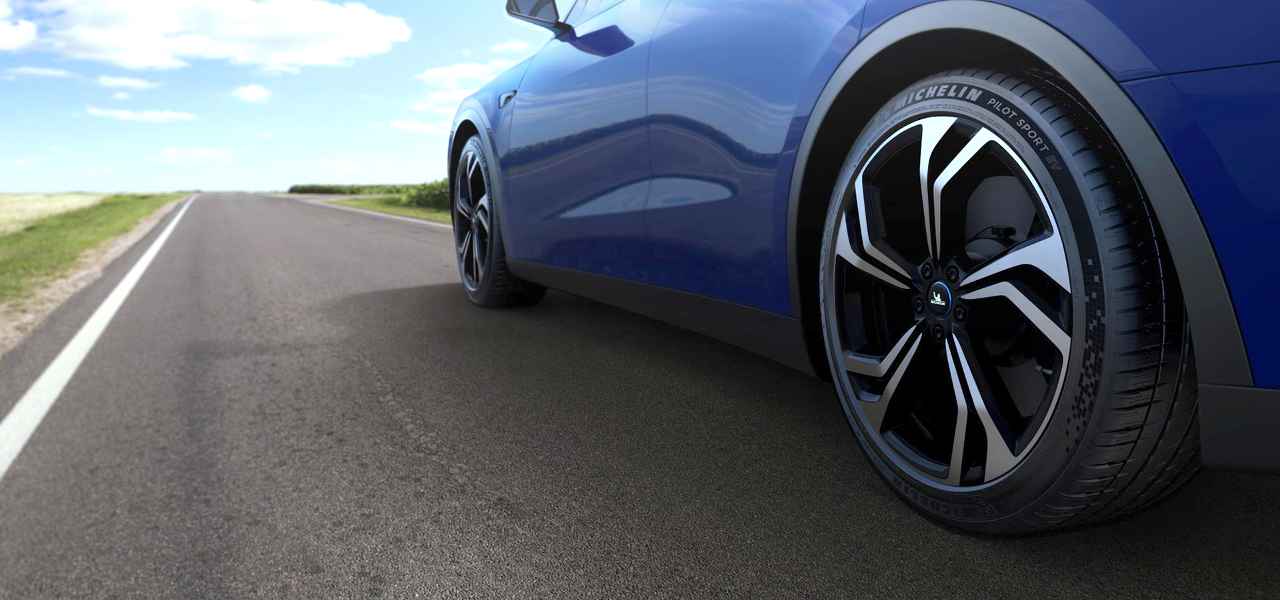 米其林针对高功率电动跑车开发了Pilot Sport EV轮胎,并表示由于采用了低滚动阻力的胎面胶料和设计,以及使用了隔音聚氨酯泡沫,这款轮胎的续航里程最多可延长37公里,同时可降低20%的路面噪声。(米其林)
米其林针对高功率电动跑车开发了Pilot Sport EV轮胎,并表示由于采用了低滚动阻力的胎面胶料和设计,以及使用了隔音聚氨酯泡沫,这款轮胎的续航里程最多可延长37公里,同时可降低20%的路面噪声。(米其林)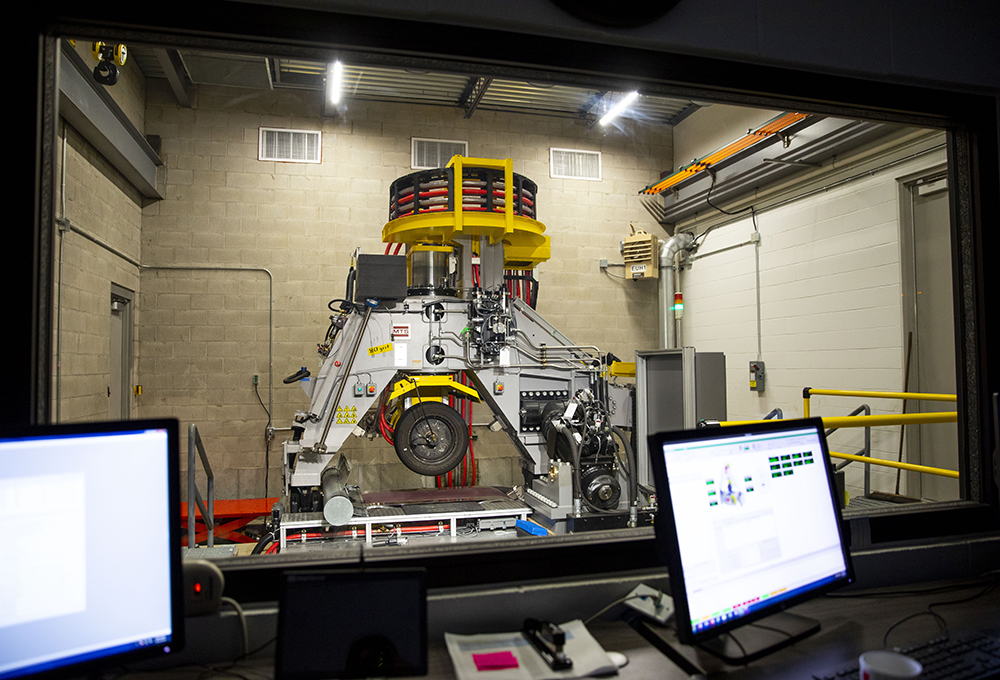 全球材料科学与工程公司Smithers开发的力和力矩测试机通过测试原型产品在不同载荷下的转向顺应性、转弯性能和制动距离等因素,帮助轮胎开发商改进电动汽车轮胎。(Smithers)
全球材料科学与工程公司Smithers开发的力和力矩测试机通过测试原型产品在不同载荷下的转向顺应性、转弯性能和制动距离等因素,帮助轮胎开发商改进电动汽车轮胎。(Smithers) 米其林技术交流总监Russell Shepherd(米其林)
米其林技术交流总监Russell Shepherd(米其林) 固特异消费轮胎技术和新轮胎研发高级总监Dave Zanzig(固特异)
固特异消费轮胎技术和新轮胎研发高级总监Dave Zanzig(固特异)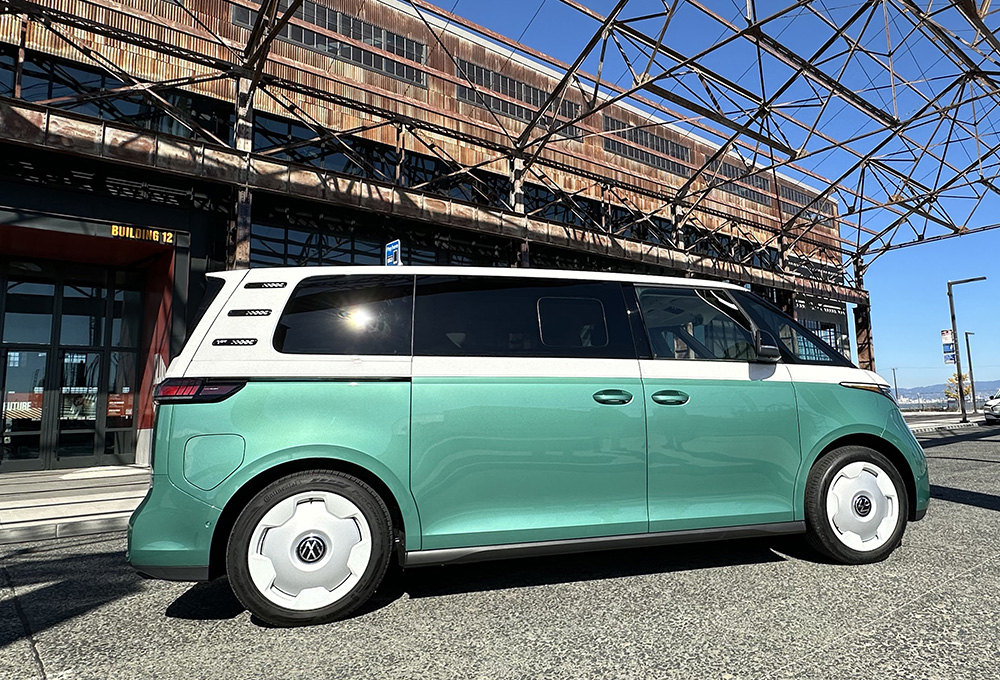 3吨重的大众ID.Buzz小型货车使用的是高负荷 “HL”等级的大陆 ProContact TX 10 轮胎,这些轮胎不是电动车专用的,但标明与电动车兼容。(John O'Dell)
3吨重的大众ID.Buzz小型货车使用的是高负荷 “HL”等级的大陆 ProContact TX 10 轮胎,这些轮胎不是电动车专用的,但标明与电动车兼容。(John O'Dell)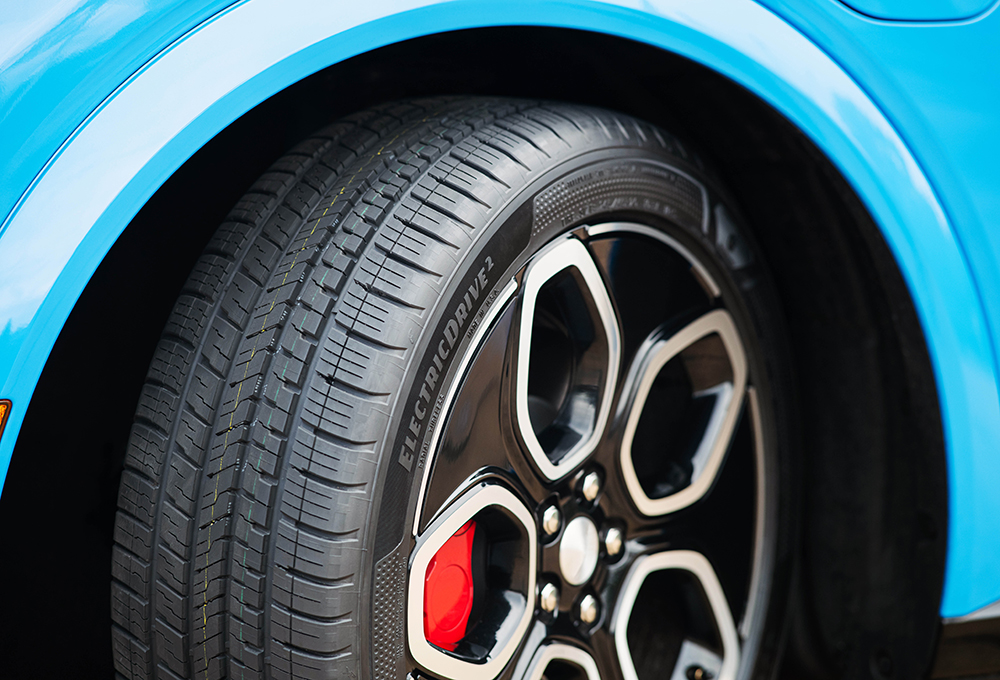 固特异开发的ElectricDrive 2在原有ElectricDrive的基础上提高了湿地牵引力。与前一代产品相比,它还具有更长的耐磨性,并且使用了至少50%的可持续材料。固特异增加了胎面花纹块和胎肩上的狭窄水平缝隙,以增加咬合边缘的数量,从而提高在湿滑路面上的牵引力。轮胎圆周上更宽的沟槽和胎面花纹块之间胎肩上的大凹槽有助于排水,提高抗水滑性。(固特异)
固特异开发的ElectricDrive 2在原有ElectricDrive的基础上提高了湿地牵引力。与前一代产品相比,它还具有更长的耐磨性,并且使用了至少50%的可持续材料。固特异增加了胎面花纹块和胎肩上的狭窄水平缝隙,以增加咬合边缘的数量,从而提高在湿滑路面上的牵引力。轮胎圆周上更宽的沟槽和胎面花纹块之间胎肩上的大凹槽有助于排水,提高抗水滑性。(固特异)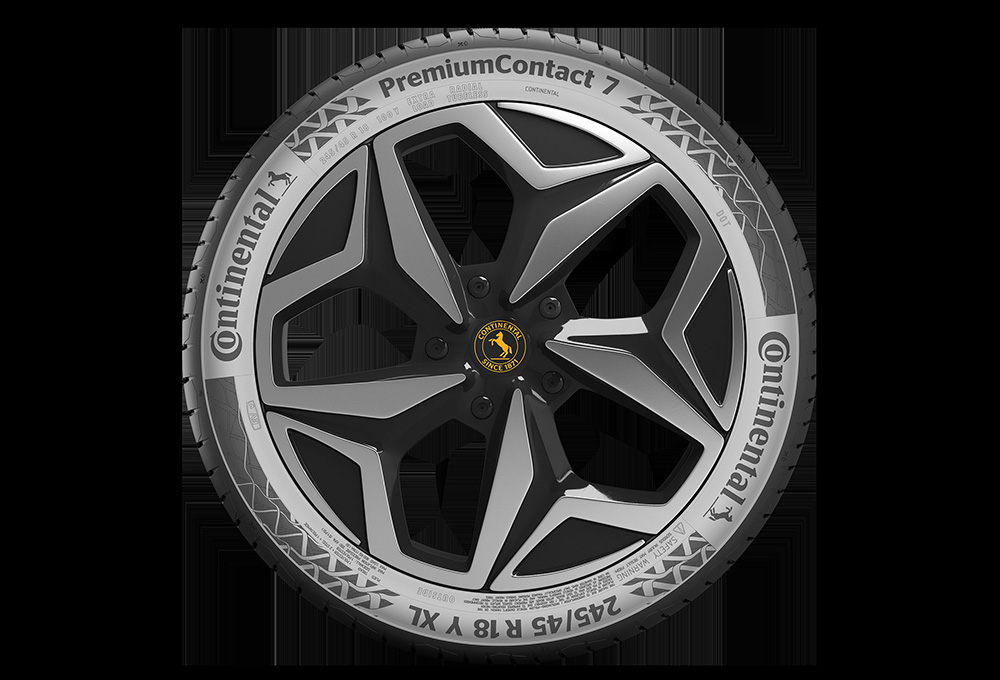 大陆集团不生产 “电动汽车专用” 轮胎,但会在一些轮胎上标注 "EV √"字样,以表明这些轮胎适用于电动车。这款 Premium Contact 7 高性能轮胎的额定载荷为 XL 或超重。(大陆集团)
大陆集团不生产 “电动汽车专用” 轮胎,但会在一些轮胎上标注 "EV √"字样,以表明这些轮胎适用于电动车。这款 Premium Contact 7 高性能轮胎的额定载荷为 XL 或超重。(大陆集团)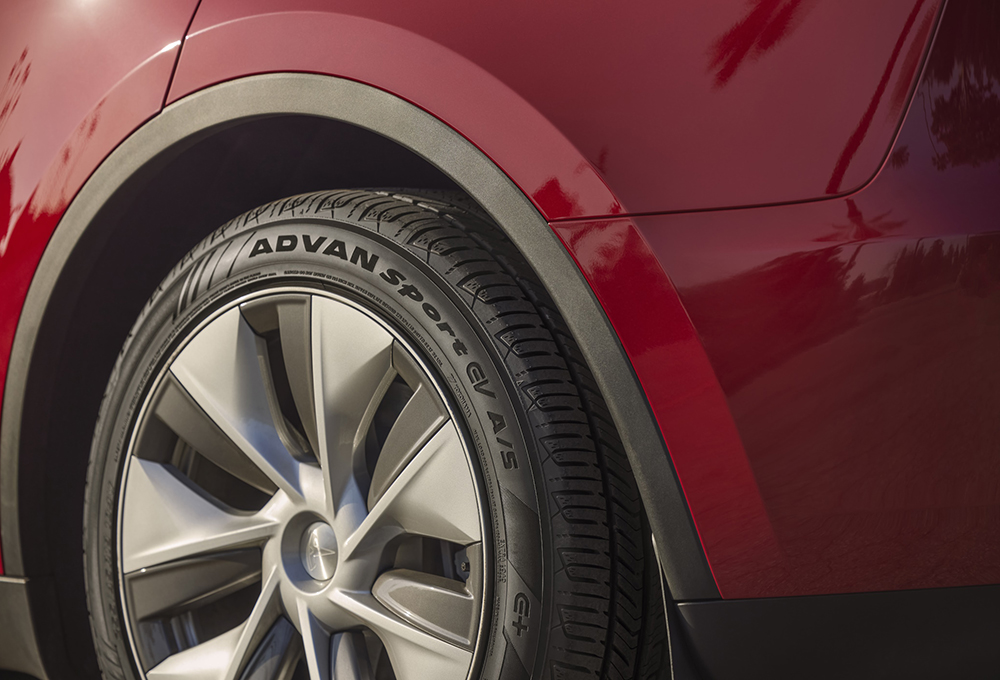 Advan Sport EV A/S 是优科豪马一款广受欢迎的运动型轮胎的电动车版本。其设计目的是在承受电动车较重重量的同时,提供舒适安静的驾乘体验。与 ElectricDrive 2 一样,它使用高二氧化硅化合物来提高胎面寿命,并采用专门设计的沟槽、凹槽、沟槽和胎面花纹块尺寸和布局来降低噪音和提高湿地性能。(优科豪马)
Advan Sport EV A/S 是优科豪马一款广受欢迎的运动型轮胎的电动车版本。其设计目的是在承受电动车较重重量的同时,提供舒适安静的驾乘体验。与 ElectricDrive 2 一样,它使用高二氧化硅化合物来提高胎面寿命,并采用专门设计的沟槽、凹槽、沟槽和胎面花纹块尺寸和布局来降低噪音和提高湿地性能。(优科豪马) 优科豪马乘用车轮胎产品规划高级经理Drew Dayton(优科豪马)
优科豪马乘用车轮胎产品规划高级经理Drew Dayton(优科豪马)
电动车通常比尺寸相近的内燃机车重20-30%。为了安全地支撑和管理这一额外的重量,电动车需要使用重载轮胎。实际上,为了应对市场上日益增长的电动车,重载(HL)轮胎标准已于2021年推出。在轮胎充气至同等胎压的情况下,重载轮胎较先前的负荷增强型(XL)标准轮胎具有更高的负载能力。
但是即便使用了重载轮胎,电动车的额外重量和较高的瞬时扭矩仍会导致轮胎与路面之间的摩擦力增加。因此,许多电动车车主会发现其轮胎磨损得更快,俄亥俄州阿克伦市全球材料科学与工程公司Smithers的咨询业务副总裁Josh Guilliams告诉SAE。该公司在测试与协助开发轮胎方面积累拥有超过99年的经验。
轮胎制造商指出,可惠及电动车的许多改进工作,尤其是在降噪和提高能效方面的工作,早在电动车普及之前就已开始了。南卡罗来纳州格林维尔市米其林北美公司技术交流总监Russell Shepherd向SAE表示,豪华SUV的出现为研发胎噪更低的轮胎提供了最初动力,因为大车厢更容易放大路面噪声。此外,美国轮胎制造商协会(U.S. Tire Manufacturers Association)高级副总裁兼总法律顾问Tracey Norberg告诉SAE,早在电动车问世前,联邦燃油效率法规就已开始推动低滚动阻力轮胎的开发了。
但电动车的问世及其市场份额的增长,促使轮胎制造商进一步加快研发同时适用于电动车和内燃机车的工艺和技术。其中最主要的一项是在轮胎空腔内使用隔音泡沫块或泡沫条,以减少胎噪。位于阿克伦市的固特异轮胎橡胶公司的消费轮胎技术与新型轮胎研发高级总监Dave Zanzig向SAE表示:这种专门设计的泡沫块可减少车厢内由空腔共振造成的噪声,最高降幅可达50%。其它重要技术还包括旨在提高胎面寿命、低滚阻和高牵引力的新型橡胶胶料(通常为专利材料),以及旨在改善潮湿天气操控性和降噪的胎面设计。专为提升胎面耐磨性能而使用高硬度胶料制造的轮胎尤其注重这一方面。Guilliams表示,合成弹性体胶料“显著提升了轮胎在牵引力、滚动阻力和磨损均衡方面的性能。”
与压力等级为32 psi的标准负载(SL)轮胎相比,相同尺寸的XL轮胎和HL轮胎的压力等级可达到42 PSI。负载指数为94的XL轮胎的承重能力略低于1500磅(680 kg),而负载指数为98的同尺寸HL轮胎的承重能力则略高于1600磅(726 kg)。HL轮胎的结构(尤其是侧壁)更为坚固,能够满足重型电动卡车的需求,比如新上市的大众ID. Buzz,该车型为双电机全轮驱动,整备质量高达3吨以上。
重载轮胎对汽车制造商而言意义非凡,因为如果不使用重载轮胎,就必须使用尺寸更大的车轮和轮胎,这将导致整车重量增加,而且轮拱空间也需要扩大,不仅会降低能效,还会占用宝贵的储物空间和客舱空间,降低电动车的竞争力。
固特异是研发可持续材料的公司之一。该公司与供应商以及大学合作研发出了一种从稻壳灰烬中提取二氧化硅的方法。二氧化硅是轮胎胶料中提高耐磨性和牵引力的一种关键成分。在全球范围内,每年都有数百万吨稻壳被用于焚烧发电,而固特异研发的这一方法不仅缓解了日益减少的全球沙储量的消耗(以沙为原料的二氧化硅约占轮胎重量的40%),还避免了二氧化硅含量较高的稻壳被填埋。Zanzig称,固特异还“用大豆油代替石油,并利用生物质生产先进聚合物”。他补充说,固特异针对电动车研发的ElectricDrive 2轮胎“含有50%的可持续材料”。
电动车专用轮胎通常注重降噪、延长胎面寿命和提高效率等性能,如固特异的Electric Drive 2、优科豪马(Yokohama)最近推出的Advan Sport EV A/S、普利司通的Turanza EV、倍耐力的P Zero AS Plus Elect和米其林的e.Primacy等轮胎。
优科豪马轮胎北美公司位于加州圣塔安,公司的乘用车轮胎产品规划高级经理Drew Dayton告诉SAE,轮胎设计所针对的特性需求各有侧重,因此种类繁多。他与大陆集团的Liu持相同观点,认为所有尺寸合适的轮胎均适用于电动车和内燃机车。即便如此,该公司还是推出了Advan Sport EV系列,旨在最大限度延长胎面寿命,同时保持“可接受的操控性、滚动阻力和噪声水平”。
Zanzig表示:“在推动电动车轮胎性能优化的创新的背后,确实有真正的技术作为支撑。”
To EV or not EV? It’s a question more and more motorists are asking as they look to purchase replacement tires for the electric vehicles that grace their garages. Should they buy special “EV tires,” or just look for good tires that fit their electron-gulping cars and light trucks? Tire engineers know it’s not a silly question and that OEMs have their work cut out for them on the education front. A 2023 Michelin survey found 83% of motorists, including half of all EV owners, didn’t understand the different tire needs of EVs and ICE cars and trucks.
EVs Are Different
A tire designed for an ICE sedan might work well on a comparable EV, but chances are that unless specifically designed to be especially quiet, energy efficient, or to carry heavier-than normal loads, it likely will disappoint in terms of tread life and perhaps other characteristics such as noise.
EVs can easily be 20-30% heavier than similarly sized ICE vehicles. Safely supporting and managing that extra weight requires a tire with a high load rating. In fact, the “High Load” (HL) designation was developed in 2021 in response to the growth of EVs in the market as a way to signal a tire with higher load capacity than one built to the former XL standard, when inflated to the same pressure.
Even so, an EV’s extra weight and instant torque create higher levels of friction where the rubber meets the road. The result is that many EV drivers find their tires wear out faster, Josh Guilliams vice president of consultancy for Smithers, a global materials science and engineering company based in Akron, Ohio, told SAE Media. Smithers has been testing and helping develop tires for more than 99 years.
While a quality set of “normal” long-wearing passenger car tires might last for up to 60,000 miles, an equivalently sized EV’s tires might need replacement after as little as 30,000 miles. Drivers of sporty EVs with lots of horsepower and torque might be lucky to see 10,000 miles out of a set of tires, Guilliams said.
Increased cabin noise is also a potential issue. Without the benefit of an ICE to mask high-frequency tire and wind noise, EV makers have had to step up their game in cabin soundproofing, enlisting tire makers to design ever-quieter tires to help keep cabins peaceful.
Finally, fuel efficiency is important to most EV drivers, which drives demand for tires with low rolling resistance since reduced friction between the tire and the road increases an EV’s ability to eke more distance out of every watt of energy in its battery pack.
Adapting to EVs
Tire makers point out that work on many improvements that benefit EVs, especially in noise suppression and efficiency, started long before plugging in modern cars was a thing. The advent of luxury SUVs whose large cabins tended to amplify road noise fostered the first efforts for quieter tires, Russell Shepherd, technical communications director for Michelin North America Inc., in Greenville, South Carolina, told SAE Media. And it was federal fuel efficiency regulations, which began long before the advent of EVs, that began the drive to develop tires with lower rolling resistance, Tracey Norberg, senior vice president and general counsel for the U.S. Tire Manufacturers Association, told SAE Media.
The arrival and growth of electric vehicles in the market pushed tire makers to speed up the development of techniques and technologies that benefit both EVs and ICE vehicles. Chief among them are the introduction of sound-deadening foam blocks or strips inside tire cavities to help reduce tire noise. The specially designed foam pieces can reduce air resonance, which finds its way into the passenger cabin as noise, by as much as 50%, Dave Zanzig, senior director of consumer tire technology and new tire development at Goodyear Tire & Rubber Co., in Akron, told SAE Media. Other techniques include new (and generally proprietary) rubber compounds to improve tread life, rolling efficiency and traction, and tire tread designs aimed at improving wet weather handling and noise reduction, especially in tires made with harder compounds to maximize tread wear. Advancements in synthetic elastomer compounds have provided “enhancements in terms of traction, rolling resistance and wear balance,” Guilliams said.
The industry also developed High Load or “HL” tires to handle higher air pressure, which provides more weight-bearing capacity, without increasing in size. HL tires are used on vehicles heavier than the SUVs and vans for which the decades-old XL – Extra Load – rating was developed.
Compared with a standard load (SL) tire with a 32 psi pressure rating, the same-sized XL and HL tires might be rated for 42 PSI. While an XL tire with a load index of 94 can carry just under 1,500 pounds (680 kg), a same-sized HL-rated tire gets a load rating of 98 and can carry just over 1,600 pounds (726 kg). An HL tire has more rugged construction, especially in the sidewalls, to handle the weight of hefty EVs such as the newly introduced Volkswagen ID.Buzz, which tips the scales at just over three tons in its dual motor, all-wheel drive configuration.
HL tires are important to automakers because the alternative – going to bigger wheels and tires – adds even more weight and often requires larger wheel well capacity. That can eat into energy efficiency as well as valuable cargo and passenger cabin space, making that EV less competitive.
Weighing Tradeoffs
Developing tires, for any type of vehicle, is “a game of checks and balances,” Joshua Sortor, product and quality director for Discount Tire, told SAE Media. The Arizona company also owns the America’s Tire chain, the online retailer Tire Rack, and the highly regarded Treadwell tire testing, evaluation and recommendation tool.
“Once you meet the load rating, it comes down to what it is you are looking for in the tire. A lot of EV owners want a quiet tire that’s very efficient, but efficiency generally sacrifices lifespan, and it’s also harder to get good winter and wet performance with a high-efficiency tire,” Sortor said.
Michelin’s family of Primacy tires, for instance, includes a line called the e.Primacy aimed at EV and hybrid owners as well as at motorists seeking maximum tread life. The ICE-oriented Primacy 4 is designed for traction and gets an “A” rating for wet grip and a “B” rating for rolling resistance. A same-size e.Primacy, designed for long tread life, gets an “A” for rolling resistance but a “B” for wet grip.
E – It’s Also for Eco-Friendly
Some tire makers also have seized on the notion that EV buyers are particularly environmentally conscious and have made sustainability a feature of tires aimed at electric and hybrid vehicle owners.
Goodyear is among those developing sustainable materials. In collaboration with suppliers and universities, the company developed a method of extracting silica, a key ingredient in tire compounds that improves wear and traction, from ashes of rice husks that are often burned by the millions of tons to generate electricity worldwide. As a result, Goodyear has reduced its consumption of the world’s declining sand reserves – approximately 40% of a tire’s weight is silica – and the silica-laden husks aren’t going into landfills. Goodyear also “uses soybean oil instead of petroleum oil and is making advanced polymers from biomass,” Zanzig said. The company’s ElectricDrive 2, a tire aimed at EV owners, “has 50% sustainable content,” he said.
The Cost Factor
One drawback to EV tires is that they can cost as much as 20% more than comparable tires without EV-specific features. The higher cost is a function of their unique materials, more rugged construction and low-volume sales, which makes it harder for manufacturers to recoup R&D, materials and marketing costs without increasing prices, said Bob Liu, research and development director for passenger cars and light trucks at Continental Tire the Americas in Fort Mill, South Carolina.
PR or Substance?
Goodyear ’s Zanzig maintains there is real technology behind EV labeling, that it’s not just PR. Continental ’s Liu, on the other hand, said that EV-labeled tires “are more focused on marketing than performance” and that “competition, not EVs, is driving tire improvements.” Both Goodyear and Continental belong to the U.S. Tire Manufacturers Association, which takes the stand that, special label or not, a properly sized tire that meets or exceeds the vehicle manufacturer’s specifications can function on both EVs and ICE vehicles. While a tire doesn’t have to be labeled “EV” to be an EV tire, such labeling can help consumers, said Discount Tire’s Sortor.
In general, EV-specific tires such as the Electric Drive 2, Yokohama’s recently introduced Advan Sport EV A/S, Bridgestone’s Turanza EV, Pirelli’s P Zero AS Plus Elect and Michelin’s e.Primacy are designed to favor attributes such as quietness, long tread life and fuel efficiency.
Tires are designed to prioritize specific goals, which leads to many varieties, Drew Dayton, senior product planning manager for consumer tires at Yokohama Tire Corp, North America, in Santa Ana, California, told SAE Media. He’s of the same school as Continental’s Liu, holding that all properly fit tires are suitable for either EV and ICE use. Even so, the company does make the Advan Sport EV line, designed for maximum tread life with “acceptable levels of handling, rolling resistance and noise.”
So, EV or Not?
The consensus among tire makers, backed up by findings from Discount Tire’s testing program, is that a tire is only as good as its load, speed, wear and weather and terrain ratings. When those things match or exceed the vehicle OEM’s tire requirements – usually posted on a label fixed to the driver’s side door jamb or the inside of the glovebox door – it shouldn’t matter whether the sidewall says anything about EVs or not. But tires specifically designed for EVs can offer electric vehicle owners additional benefits.
“There is definitely a need for tires that are customized to support the unique performance attributes of EVs,” Guilliams said, noting that tire makers have invested “significant resources” into developing tread formulations to extend an EV tire’s life without sacrificing grip or rolling resistance.
“There’s real technology fueling the innovation behind optimizing tire performance for electric vehicles,” Zanzig said.
等级
打分
- 2分
- 4分
- 6分
- 8分
- 10分
平均分
